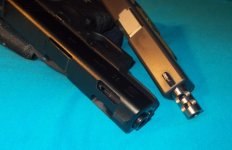Also, the 19 is great. The 19C? I'd reconsider. At least get a normal barrel for it.
I do a lot of shooting from retention and then extended if the drill asks for it. The powder burns and flash from that compensation isn't pleasant.
The porting is advantageous for reducing muzzle flip.
I carry appendix IWB, given the presence of important
(to me) and irreplaceable parts nearby ... shooting from retention - nope.
Today, I decided to shoot several guns and
compare subjectively the ease / quickness of getting two rounds onto a 6'' circle at 6-7 yards.
I shot each pistol two rounds (double tap), then move to the next.
I was easily quickest with the Glock 19C and 19 with extended ported barrel.
Close behind was my Glock 23C and 23 with extended ported barrel.
Noticeably slower was my Glock 21SF and 30SF that had an extended ported barrel.
I would be content to carry either the 19C/19 with extended ported barrel or the 23C/23 with extended ported barrel.
Factory porting reduces muzzle flip the greatest, but reduces velocity.
Extended ported barrel reduces muzzle flip and increases velocity.
Chrono averages from previous sessions:
Glock 19c:
Golden Saber 124 gr. +P @ 1,126 fps
Glock 19 stock barrel:
HST 147 gr. +P @ 1,035 fps
Remington Golden Saber 124 +P @ 1,131 fps
HST 124 +P @ 1,200 fps
Glock 19 Lone Wolf extended ported barrel:
HST 147 gr. +P @ 1,068 fps
Remington Golden Saber 124 +P @ 1,150 fps
HST 124 +P @ 1,223 fps
Glock 23c:
HST 180 @ 968 fps
Ranger T 165 @ 1,082 fps
Glock 23 stock barrel:
Ranger T 165 gr. @ 1,139 fps
Gold Dot 180 gr. @ 953 fps
Glock 23 Lone Wolf extended ported barrel:
Ranger T 165 gr. @ 1,186 fps
Gold Dot 180 gr. @ 969 fps
Looking at testing of heavy clothed gel done by Lucky Gunner:
http://www.luckygunner.com/labs/self-defense-ammo-ballistic-tests/
9mm 147 HST - 15.2'' / .61
(973 fps)
9mm 124 HST - 18.3'' / .61
(1,135 fps)
40 S&W 180 HST - 18.5'' / .72
(964 fps)
45 acp 230 HST - 14'' / .85
(822 fps)
For now, I've decided to go with the 19C / 19 extended ported barrel for maximum capacity and speed / ease of placing shots onto target.

